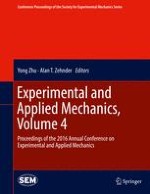2017 | Book
Experimental and Applied Mechanics, Volume 4
Proceedings of the 2016 Annual Conference on Experimental and Applied Mechanics
Editors: Yong Zhu, Alan T. Zehnder
Publisher: Springer International Publishing
Book Series : Conference Proceedings of the Society for Experimental Mechanics Series
